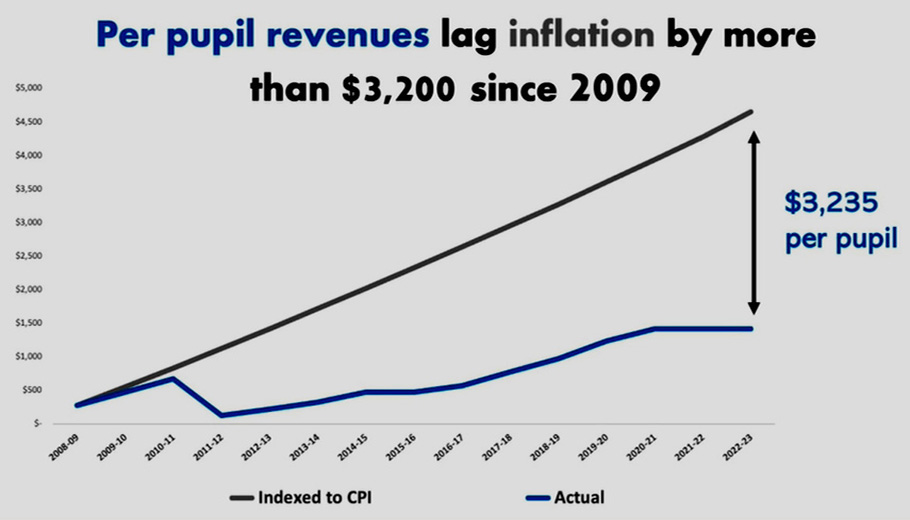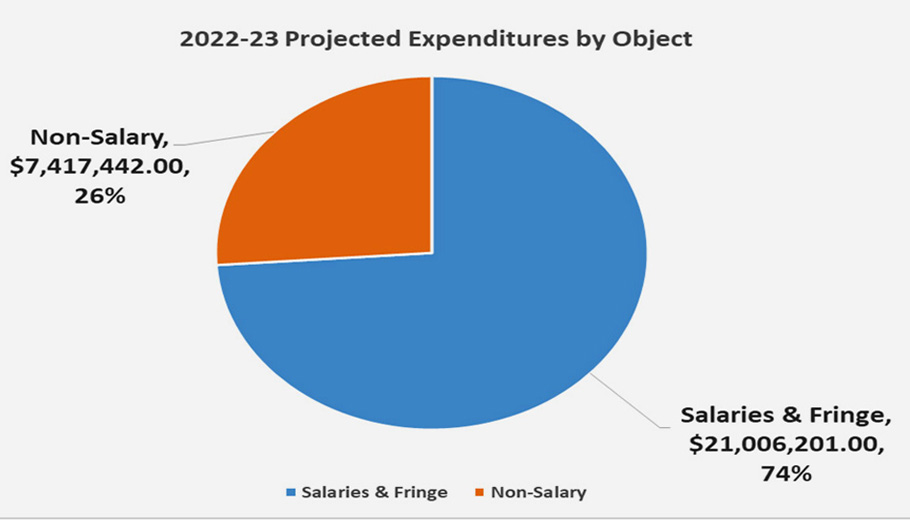
All staff to get raises in 2023-24
By Robert Cloud
The Waupaca School Board voted to give teaching, administrative and support staff 5% raises for 2023-24.
The increases were all recommended by Carl Hayek, the district’s director of business services.
“Our district’s long-term sustainability depends on logical economic principles of supply and demand,” Hayek told the board. “We are not like the private sector, where businesses can simply increase their prices. When we spend more than we have, we increase taxes.”
He said the personnel budget is more than salaries and hourly pay. It includes health and dental insurance, short- and long-term disability, payments into the Wisconsin Retirement System (WRS), FICA, Social Security, employee flex plans, extra duty pay, substitute pay and pay for professional development, extended contracts and extracurricular duties, as well as Employee Tax-sheltered Annuity Management.
“When all salaries go up, the district is responsible for a 7% WRS on that number,” Hayek said.
Revenues caps and spending
The state sets revenues caps on school district spending, which determines the level of general state aid a district receives and the level of property taxes a district levies.
“The revenue cap controls 88.12% of our money,” Hayek said. “Over the past years it hasn’t gone up at all.”
State funding accounted for 46.7% of the Waupaca School District’s general operating funding last year, while property taxes were 41.4% of total revenues.
Hayek said the governor’s proposed 2023-25 budget for K-12 education is probably double what the legislature will approve.
“The best-case scenario is that state revenues will increase by 4%, not 8%,” he said.
Compounded expenses
“Anything new, any added percentage increase for any annual item, increases the budget by that amount forever unless an annual budget reduction is made in the same amount,” Hayek said.
He argued that deficit spending has long-term implications of a cycle of going to referendums year after year to exceed the revenue cap to cover the higher salaries.
He said relying on referendums for operating expenses is unsustainable.
“Once a district starts exceeding the revenue cap without draconian budget cuts, it is extremely difficult to stop short-term borrowing and a district depletes its fund balance in the process,” Hayek said.
Hayek showed a possible scenario where the Waupaca School District increased salaries and benefits by 4.5% and other budget items by 3%, while growing revenues by only 1%.
By 2025-26, the district was running an annual $2.9 million deficit and the fund balance had dropped from $11.24 million in 2022-23 to $5.48 in 2025-26.
Hayek said a budget shortfall begins compounding, growing larger year after year, until there is no fund balance.
“Within three years, the district will be short-term borrowing,” Hayek said. “You can’t borrow money if you don’t have a fund balance.”
Per pupil spending
“How do we balance our budget?” Hayek asked.
The state of Wisconsin has dropped from being ranked No. 11 nationwide in per-pupil spending in 2002 to No. 25 in 2020, Hayek said.
In 2002, Wisconsin per pupil spending for public education was 11% above the national average, in 2020 it was 5.6% below the national average.
Hayek described it as “the largest drop in rankings of any state and that was before the 2021-23 funding freeze.”
Declining enrollments
Nearly three-quarters of school districts in Wisconsin have been experiencing declining enrollment, including Waupaca.
Waupaca’s enrollment has dropped from 2,461 in 2004-05 to 1,993 in 2021-22.
Over the past five years, while the number of students dropped by more than 100, the number of teachers decreased from 183.8 to 181.8.
“We didn’t lay off any teachers,” Hayek said.
Referendums
Hayek noted that while Wisconsin voters approved 83% of school referendums for operating expense above the revenue cap, they passed only 52% in 2023.
“This district hasn’t had a referendum to exceed the revenue cap, ever,” Hayek said. “There are only 19 school districts that have done that. We’re fiscally solvent.”

Raises not matching CPI
Although the Consumer Price Index, which measures inflation, was at 8% for much of 2022, most districts are raising salaries by less than 5%.
The average increase in teachers’ salaries in Wisconsin has been 4.41%.
Given revenue caps and declining enrollments, districts cannot afford to give raises of 8%.
Hayek said a 5% increase in pay, for all district employees, including salaries and benefits, would cost the district about $1.32 million.
He also projected a $1.3 million increase in revenues in 2023-24 that would cover most of the higher salaries.
“If one group wants more, what’s the alternative?” Hayek asked.
To increase teacher pay by 8%, 22 teachers assistants would have to be eliminated, or all other district employees’s wages would have to be frozen, of all teachers’ extra duty pay and extended contracts would be eliminated.
“Are we in this together?” Hayek said. “One group of employees can’t really in good conscience think it’s all for them.”
Salary matrixes
Individual teachers are paid according to a matrix that takes into account the number of years they have worked and the level of education they have attained.
For example, a first-year teacher with a bachelor’s degree earned a base salary of $40,040 in 2022-23, while a teacher with 10 years of experience and a master’s degree earned $62,028,
With a 5% pay raise, a first-year teacher will earn base salary of $41,734 in 2023-24, while a teacher with 10 years of experience and a master’s degree will earn $64,651.
These stories do not include fringe benefits, which are also calculated as part of the 5% increase.
Hayek’s recommendations
• Increase the teacher salary matrix for certified teaching staff for the 2023-24 school year by 5%.
• District nurses, secretaries, administration and district office staff as well receive the same increase of 5%. The total increase for these employee groups equates to $137,417.
• All athletic/non-athletic extracurricular pay remain at the same levels as 2022-23 school year.
• Increase food service, custodial, maintenance, educational assistants and special educational assistants receive a 5% increase to all their 2023-24 salary matrixes with special educational assistants getting $1 per hour in addition to the 5% increase on their salary matrix.
The school board unanimously approved all of Hayek’s recommendations.
